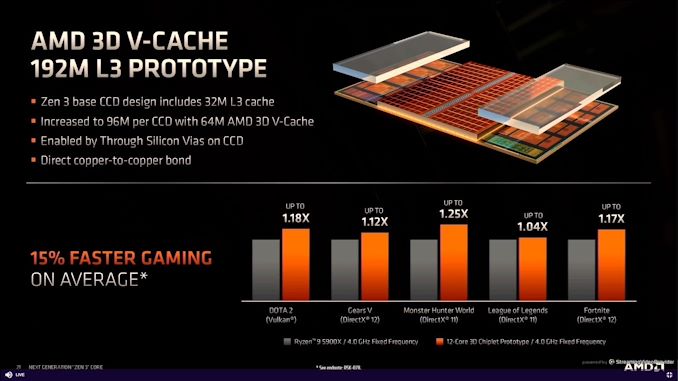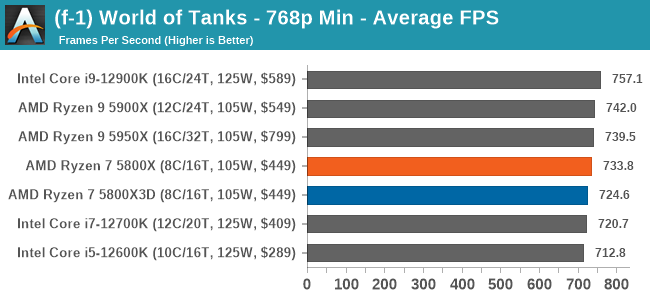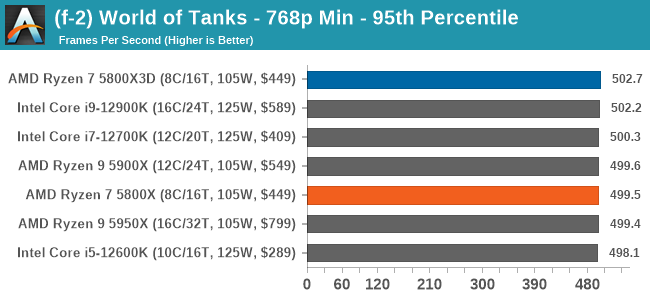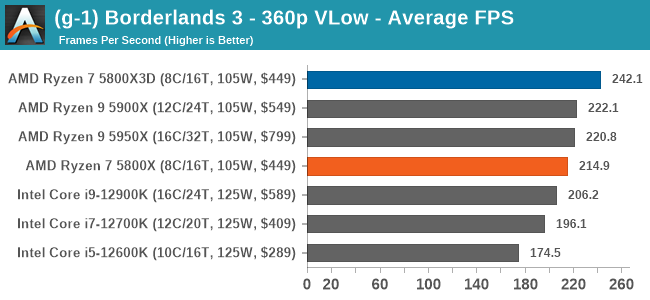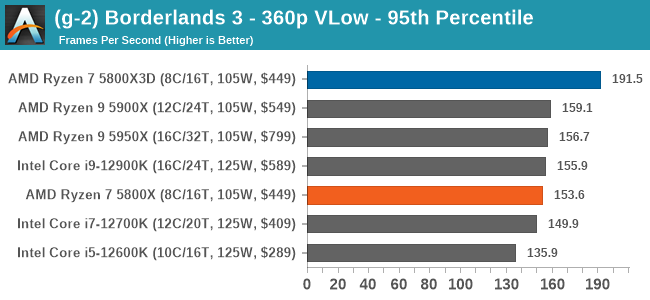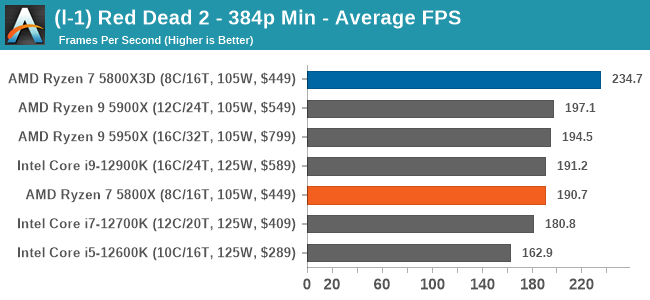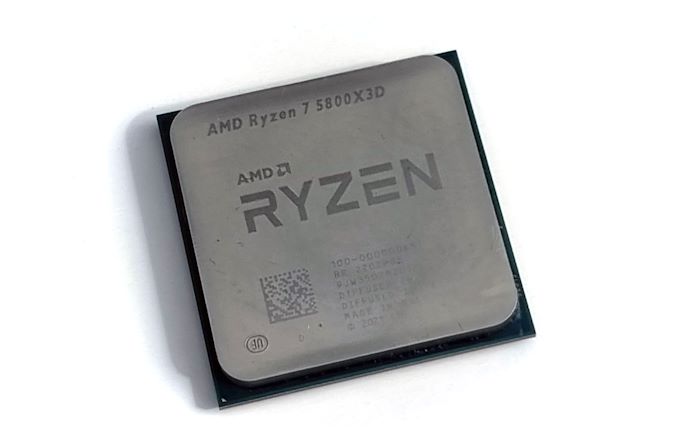
Original Link: https://www.anandtech.com/show/17337/the-amd-ryzen-7-5800x3d-review-96-mb-of-l3-3d-v-cache-designed-for-gamers
The AMD Ryzen 7 5800X3D Review: 96 MB of L3 3D V-Cache Designed For Gamers
by Gavin Bonshor on June 30, 2022 8:00 AM EST- Posted in
- CPUs
- AMD
- DDR4
- AM4
- Ryzen
- V-Cache
- Ryzen 7 5800X3D
- Zen3
- 3D V-Cache
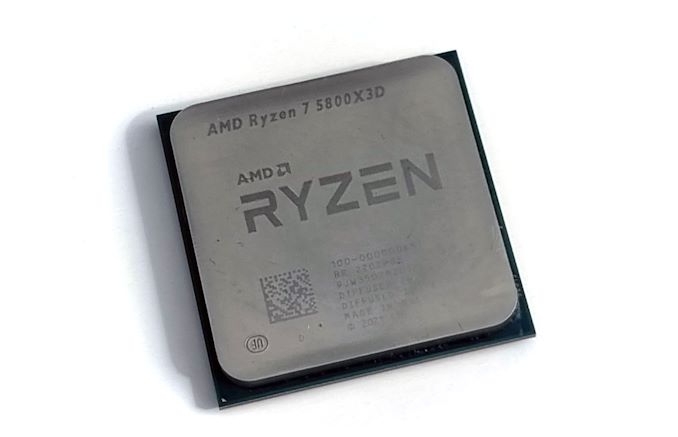
The level of competition in the desktop CPU market has rarely been as intensive as it has been over the last couple of years. When AMD brought its Ryzen processors to market, it forced Intel to reply, and both have consistently battled in multiple areas, including core count, IPC performance, frequency, and ultimate performance. The constant race to improve products, stay ahead of the competition, and meet customers' changing needs has also sent the two companies off of the beaten paths at times, developing even wilder technologies in search of that competitive edge.
In the case of AMD, one such development effort has culminated with 3D V-Cache packaging technology, which stacks a layer of L3 cache on top of the existing CCD's L3 cache. Owing to the fact that while additional cache is beneficial to performance, large quantities of SRAM are, well, large, AMD has been working on how to place more L3 cache on a CPU chiplet without blowing out the die size altogether. The end result of that has been the stacked V-Cache technology, which allows the additional cache to be separately fabbed and then carefully placed on top of a chip to be used as part of a processor.
For the consumer market, AMD's first V-Cache equipped product is the Ryzen 7 5800X3D. Pitched as the fastest gaming processor on the market today, AMD's unique chip offers eight cores/sixteen threads of processing power, and a whopping 96 MB of L3 cache onboard. Essentially building on top of the already established Ryzen 7 5800X processor, the aim from AMD is that the additional L3 cache on the 5800X3D will take gaming performance to the next level – all for around $100 more than the 5800X.
With AMD's new gaming chip in hand, we've put the Ryzen 7 5800X3D through CPU suite and gaming tests to see if it is as good as AMD claims it is.
AMD Ryzen 7 58003XD: Now With 3D V-Cache
Previously announced at CES 2022, the Ryzen 7 58003XD is probably the most interesting of all of its Ryzen based chips to launch since Zen debuted in 2017. The reason is that the Ryzen 7 5800X3D uses AMD's own 3D V-Cache packaging technology that essentially plants a 64 MB layer of L3 cache on top of the existing 32 MB of L3 cache that the Ryzen 7 5800X has.
To outline the framework of the 3D V-Cache, AMD is using a direct copper-to-copper bonding process, with the additional layer of 64 MB L3 cache stacked on top of the existing 32 MB L3 cache on the die. AMD claims this increases gaming performance by 15% on average when comparing the Ryzen 9 5900X (12c/16t) to a 12-core 3D chiplet prototype chip. Whether AMD's claim is based solely on the 12-core design or if this level of performance increase is linear when using fewer cores is hard to determine.
It is clear that 3D V-Cache and its innovative bonding technique, which fuses additional L3 cache on top of existing L3 cache, is an interesting way to deliver solid performance gains, given how crucial L3 cache levels can be for specific game titles. AMD also claims that the large levels of L3 cache improve performance in multi-threaded workloads such as video encoding.
The design of the Vertical (V) Cache is based on the same TSMC 7 nm manufacturing process as the CCD, with a thinning process that is part of TSMC's technologies designed to negate any thermal complications that would arise. Bridging the gap between the 32 MB of on-die L3 cache and the vertically stacked 64 MB of L3 Cache is a base of structural silicon, with the direct copper to copper bonding and connected by silicon VIAs and TSVs.
Looking at where it positions itself in the stack, the Ryzen 7 5800X3D is unequivocally the same price as the Ryzen 9 5900X, which benefits from four additional Zen 3 cores, as well as eight additional threads. The Ryzen 7 5800X3D does have a lower base frequency than the Ryzen 7 5800X by 400 MHz, with a 200 MHz lower turbo frequency. This will likely be a power limiting factor as the additional L3 cache will generate power.
| AMD Ryzen 5000 Series Processors for Desktop (>$200) Zen 3 Microarchitecture (Non-Pro, 65W+) |
|||||||||
| AnandTech | Core/ Thread |
Base Freq |
1T Freq |
L3 Cache |
iGPU | PCIe | TDP | SEP | |
| Ryzen 9 5950X | 16 | 32 | 3400 | 4900 | 64 MB | - | 4.0 | 105 W | $590 |
| Ryzen 9 5900X | 12 | 24 | 3700 | 4800 | 64 MB | - | 4.0 | 105 W | $450 |
| Ryzen 9 5900 | 12 | 24 | 3000 | 4700 | 64 MB | - | 4.0 | 65 W | OEM |
| Ryzen 7 5800X3D | 8 | 16 | 3400 | 4500 | 96 MB | - | 4.0 | 105 W | $449 |
| Ryzen 7 5800X | 8 | 16 | 3800 | 4700 | 32 MB | - | 4.0 | 105 W | $350 |
| Ryzen 7 5800 | 8 | 16 | 3400 | 4600 | 32 MB | - | 4.0 | 65 W | OEM |
| Ryzen 7 5700X | 8 | 16 | 3400 | 4600 | 32 MB | - | 4.0 | 65 W | $299 |
| Ryzen 5 5600X | 6 | 12 | 3700 | 4600 | 32 MB | - | 4.0 | 65 W | $230 |
As the 3D V-Cache is primarily designed to improve performance in game titles, the new chip isn't too far from the Ryzen 7 5800X in regards to raw compute throughput. There will be a slight advantage to the Ryzen 7 5800X and Ryzen 9 5900X in this area with higher core frequencies on both models. Still, as I've previously mentioned, the real bread and butter will be in gaming performance or at least games that will benefit and utilize the extra levels of L3 cache.
AMD Ryzen 7 5800X3D: Overclocking Support for Memory, But not the Core
Although the Ryzen 7 5800X3D supports memory overclocking and allows users to overclock the Infinity Fabric interconnect to supplement this, AMD has disabled core overclocking, which makes it incompatible with AMD's Precision Boost Overclocking feature. This has disappointed a lot of users, but it is a trade-off associated with the 3D V-Cache.
Specifically, the limitations in overclocking come down to voltage limitations ( 1.35 V VCore) through the use of its packaging technology. The dense V-cache dies, it would seem, can't handle extra juice as well as the L3 cache already built into the Zen 3 chiplets.
As a result, in lieu of CPU overclocking, the biggest thing a user can do to influence higher performance with the Ryzen 7 5800X3D is to use faster DDR4 memory with lower latencies, such as a good DDR4-3600 kit. These settings are also the known sweet spot for AMD's Infinity Fabric Interconnect as set out by AMD.
Looking at the state of the desktop processor market as it is now, and by the end of the year, things look promising for users with plenty of choices available. The primary battle right now in gaming performance comes down to AMD's Ryzen 7 5800X3D ($450) and Intel's 12th Gen Core series options, with the Core i9-12900K leading the charge for team Intel.
Perhaps the most interesting debate is when it comes to buying a new processor, as both the current generational offerings from both AMD and Intel offer superb gaming performance on the whole. It's tough to select a mainstream desktop processor that doesn't work well with most graphics cards, and outside pairing up a flagship chip with a flagship video card, it will most likely come down to performance in compute, productivity, and content creation applications. We know that AMD is releasing its latest Zen 4 core later on this year, and we have come to expect advancements and progression in IPC performance.
The AMD Ryzen 7 5800X3D with its 3D V-Cache is new and exciting, and specifically for gaming performance, the battle for the title of 'fastest gaming processor' is ever-changing. Based on the existing AM4 platform, AMD has given users a leading-edge design in a familiar platform, but the biggest challenge will be in making true of AMD's claims, and that's what we aim to do in this review.
Finally, regardless of how the 5800X3D does today, AMD's stacked V-cache technology is not a one-and-done offering. AMD recently announced there will be a Zen 4 variation with 3D V-Cache at some point during the cycle, as well as announcing the same for Zen 5, which is expected in 2024.
For our testing, we are using the following:
| Ryzen Test System (DDR4) | |
| CPU | Ryzen 7 5800X3D ($450) 8 Cores, 16 Threads 105W TDP, 3.4 GHz Base, 4.5 GHz Turbo |
| Motherboard | ASUS ROG Crosshair VIII Extreme (X570) |
| Memory | ADATA 2x32 GB DDR4-3200 |
| Cooling | MSI Coreliquid 360mm AIO |
| Storage | Crucial MX300 1TB |
| Power Supply | Corsair HX850 |
| GPUs | NVIDIA RTX 2080 Ti, Driver 496.49 |
| Operating Systems | Windows 11 Up to Date |
For comparison, all other chips were run as tests listed in our benchmark database, Bench, on Windows 10 and 11 (for the more recent processors).
Gaming Performance: 720p and Lower
All of our game testing results, including other resolutions, can be found in our benchmark database: www.anandtech.com/bench. All gaming tests were with an RTX 2080 Ti.
For our gaming tests in this review, we re-benched the Ryzen 7 5800X processor to compare it directly against the newer Ryzen 7 5800X3D on Windows 11. All previous Ryzen 5000 processor were tested on Windows 10, while all of our Intel Alder Lake (12th Gen Core Series) testing was done on Windows 11.
We are using DDR4 memory at the following settings:
- DDR4-3200
Civilization VI
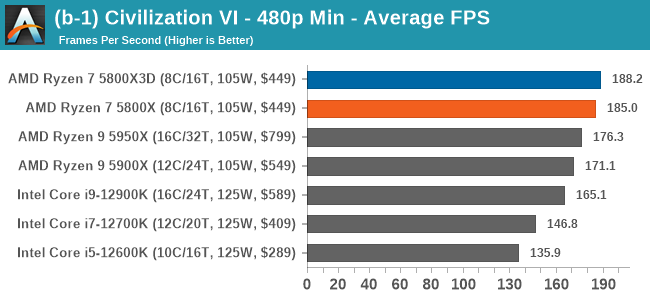
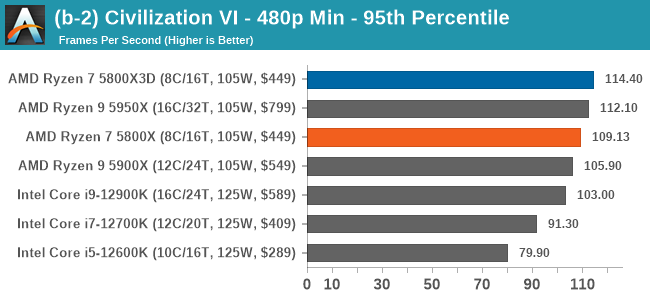
Final Fantasy 14
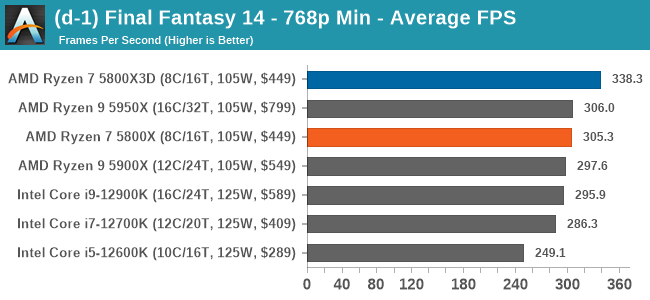
Final Fantasy 15
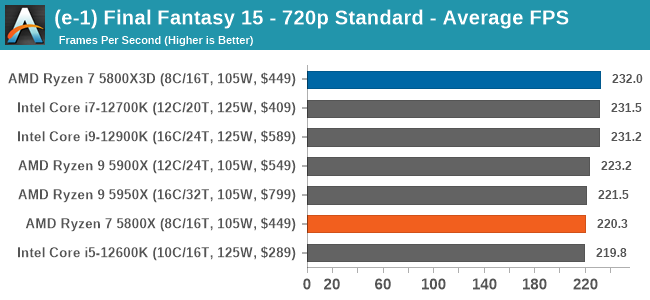
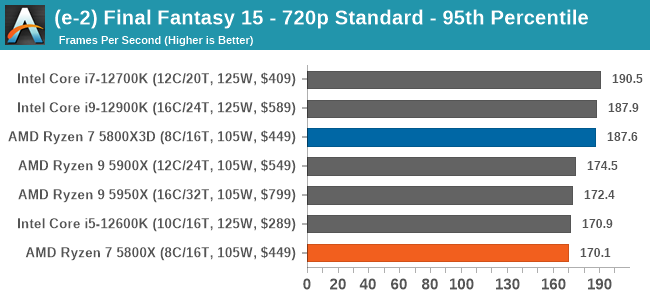
World of Tanks
Borderlands 3
Far Cry 5
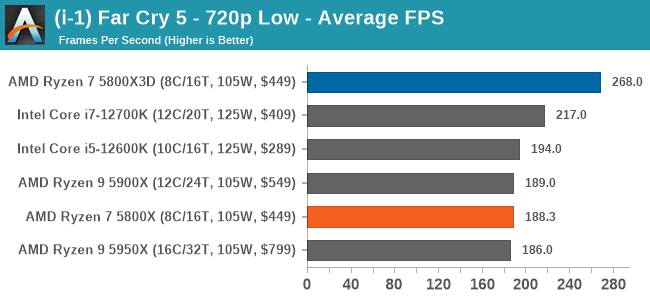

Gears Tactics

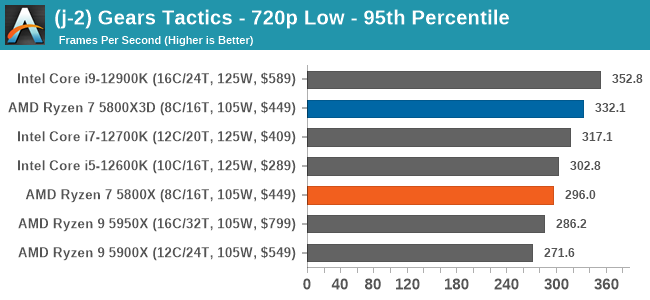
Grand Theft Auto V
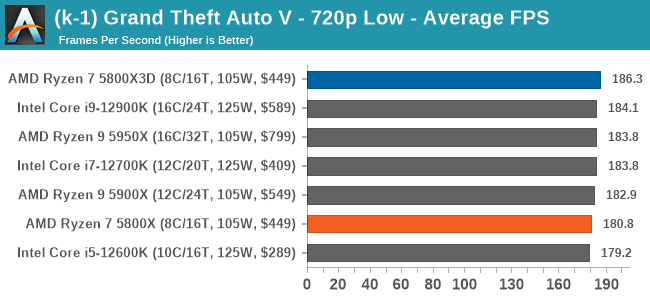
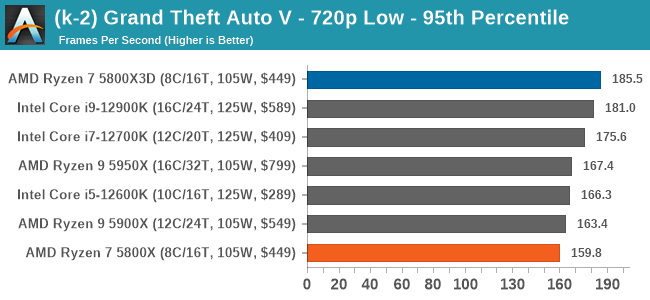
Red Dead Redemption 2
Strange Brigade (DirectX 12)
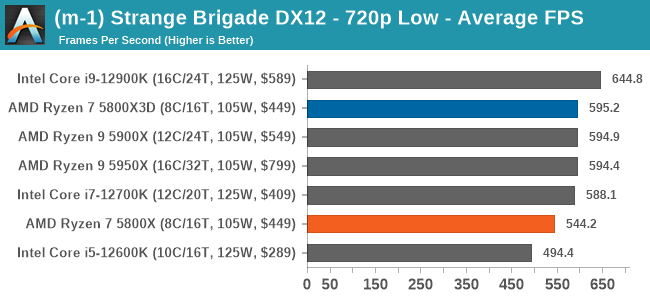
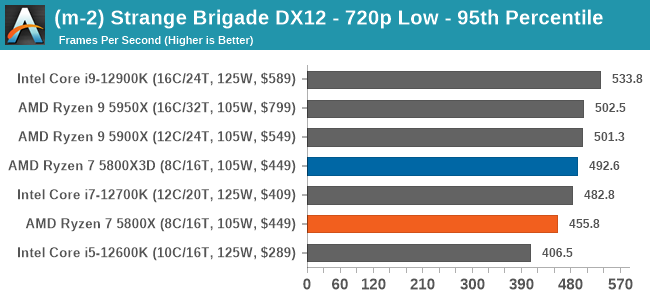
Strange Brigade (Vulcan)
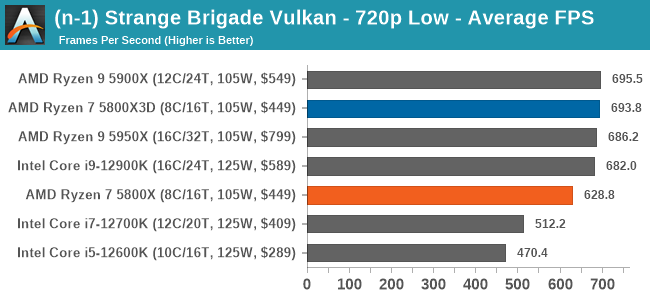
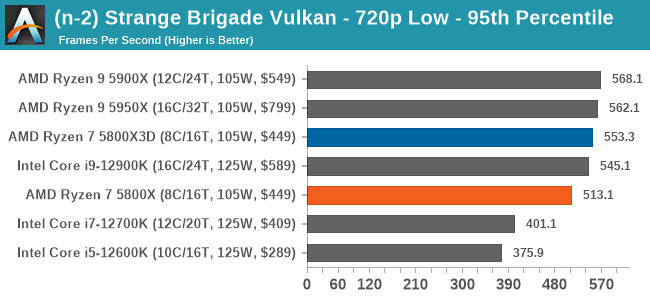
At 720p resolutions and lower, we are significantly (and intentionally) CPU limited. All of which gives the Ryzen 7 5800X3D and its 3D-Vache the chance to shine.
The addition of 3D V-Cache to one of AMD's mid-range chips makes the Ryzen 7 5800X3D a much more potent option in gaming, with much better performance consistently than the Ryzen 7 5800X. This is very much a best-case scenario for AMD, and as we'll see, won't be as applicable to more real-world results (where being GPU limited is more common). But it underscores why AMD is positioning the chip as a gaming chip: because many of these workloads do benefit from the extra cache (when they aren't being held-back elsewhere).
In any case, the 5800X3D compares favorably to its more direct competition, the Intel Core i9-12900K and Ryzen 9 5950X (which are both more expensive options). In AMD partnered titles, the Ryzen 7 5800X3D does extremely well.
Gaming Performance: 1080p
All of our game testing results, including other resolutions, can be found in our benchmark database: www.anandtech.com/bench. All gaming tests were with an RTX 2080 Ti.
For our gaming tests in this review, we re-benched the Ryzen 7 5800X processor to compare it directly against the newer Ryzen 7 5800X3D on Windows 11. All previous Ryzen 5000 processor were tested on Windows 10, while all of our Intel Alder Lake (12th Gen Core Series) testing was done on Windows 11.
We are using DDR4 memory at the following settings:
- DDR4-3200
Civilization VI
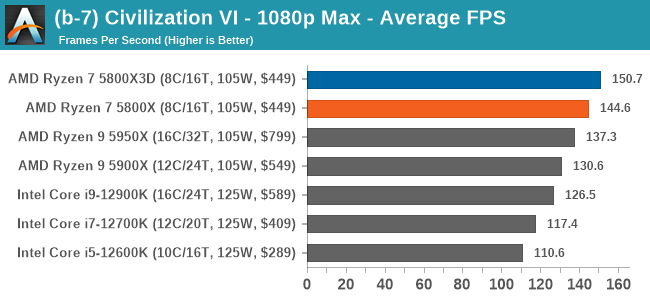
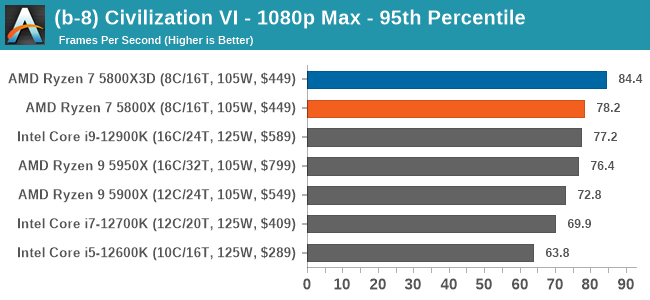
Final Fantasy 14
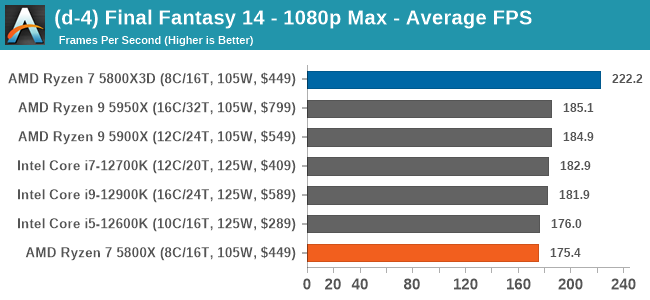
Final Fantasy 15
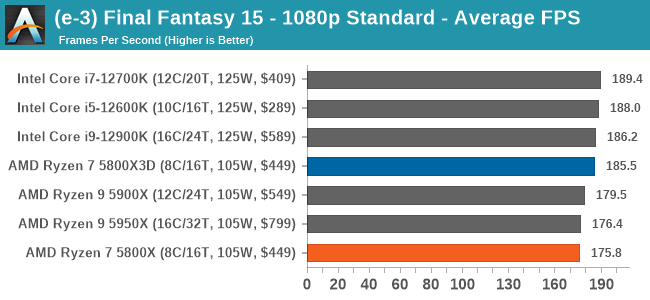
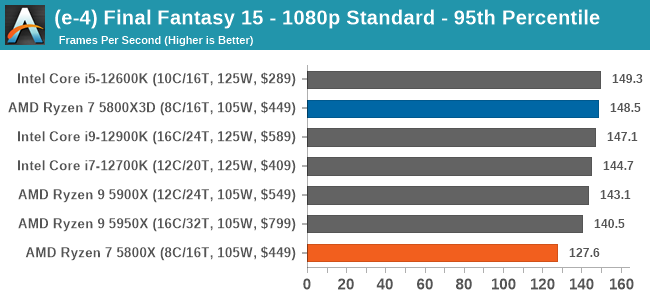
World of Tanks
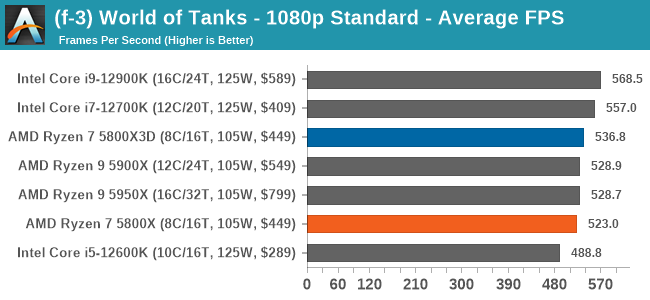
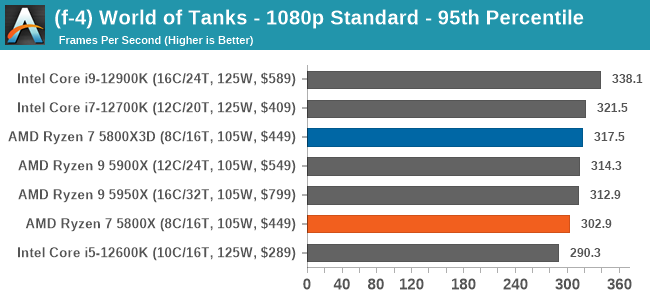
Borderlands 3
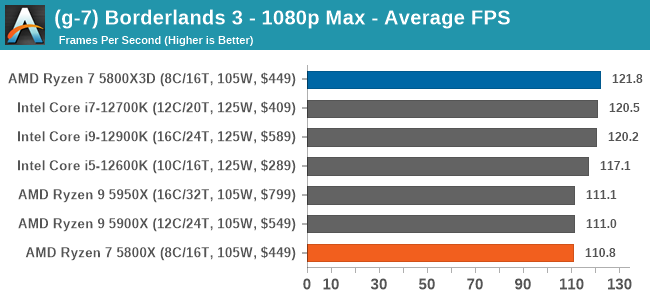
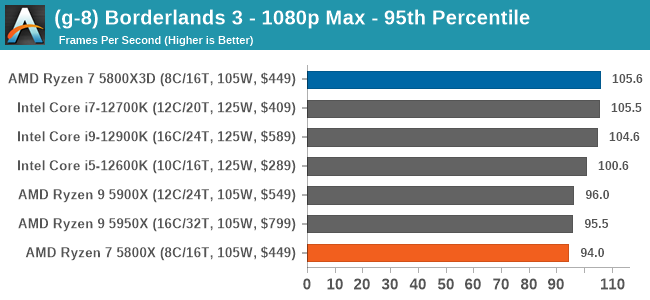
Far Cry 5
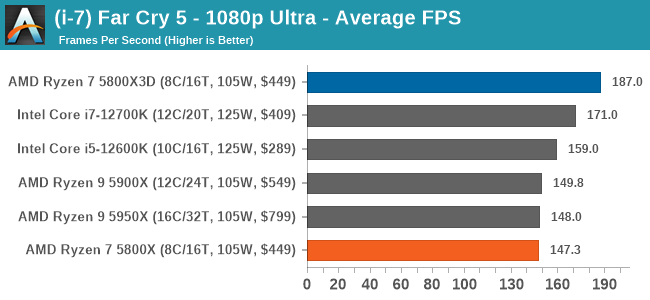
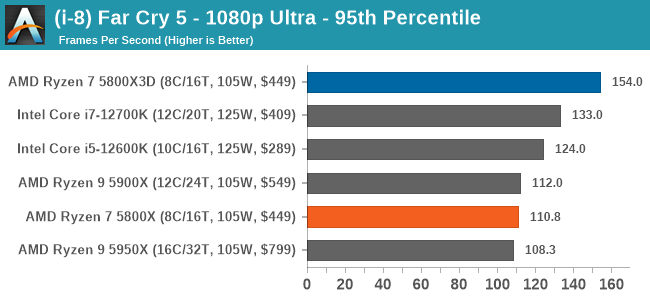
Gears Tactics
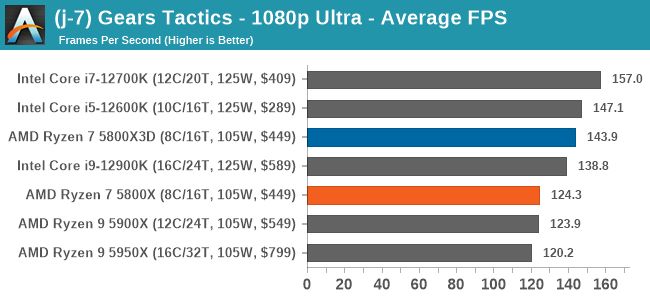
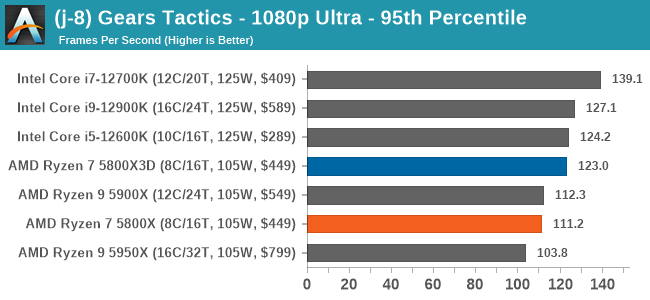
Grand Theft Auto V
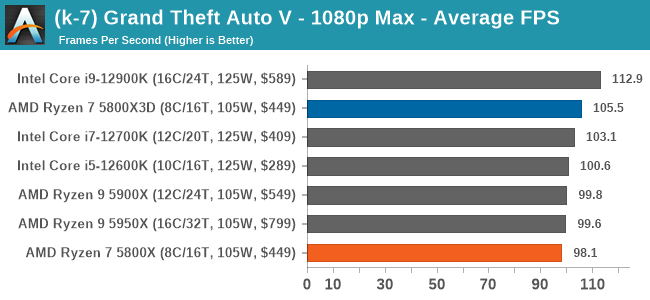
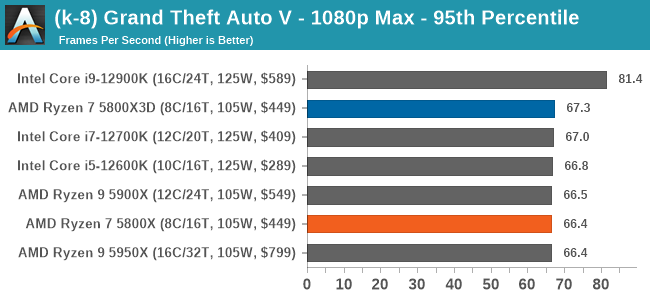
Red Dead Redemption 2
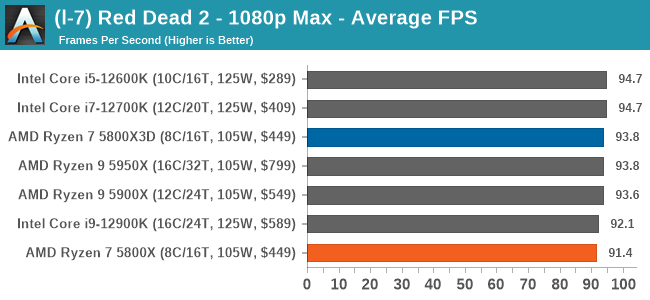
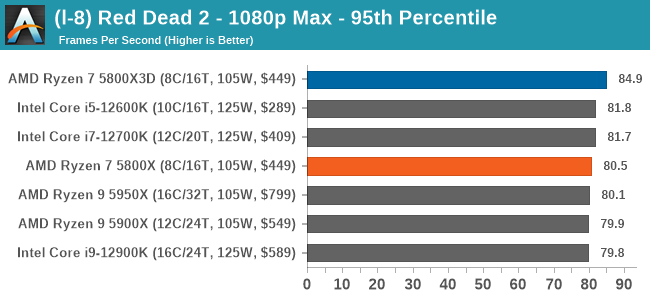
Strange Brigade (DirectX 12)
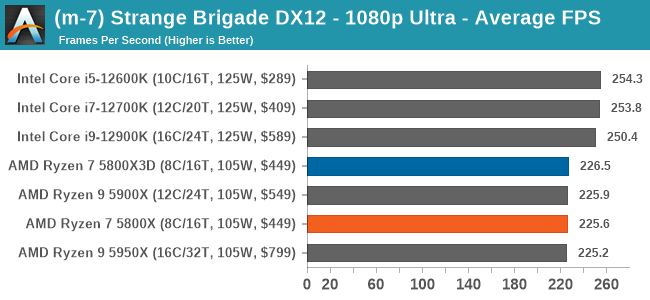
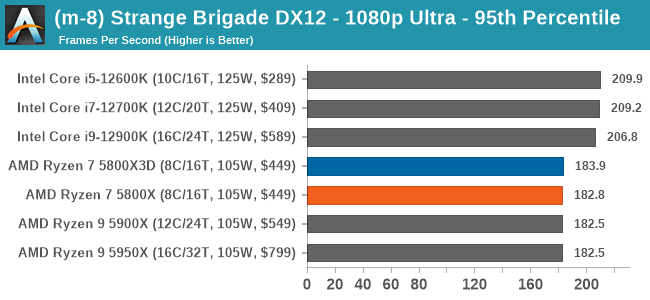
Strange Brigade (Vulcan)
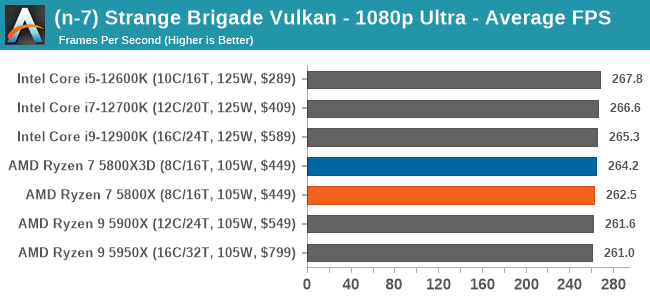
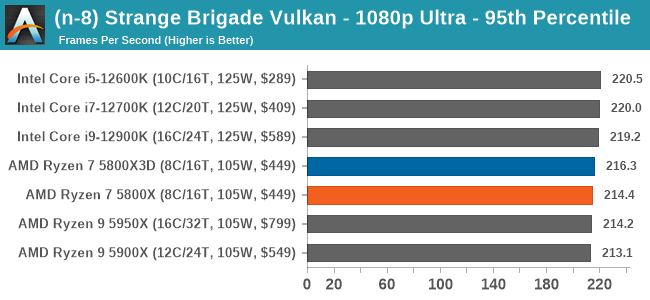
Focusing on our test suite at 1080p resolutions, again the AMD Ryzen 7 5800X3D performs well compared with other Ryzen 5000 processors and Intel's Alder Lake processors. In certain situations, Intel's 12th Gen Core with its higher IPC performance and faster core frequencies performs better, but only in certain titles where extra L3 cache doesn't have an effect on performance.
In titles that favor V-Cache, the performance differences are pretty conclusive and where extra L3 cache can be utilized, the 5800X3D and its 96 MB of 3D V-Cache sit comfortably above the competition.
Gaming Performance: 4K
All of our game testing results, including other resolutions, can be found in our benchmark database: www.anandtech.com/bench. All gaming tests were with an RTX 2080 Ti.
For our gaming tests in this review, we re-benched the Ryzen 7 5800X processor to compare it directly against the newer Ryzen 7 5800X3D on Windows 11. All previous Ryzen 5000 processor were tested on Windows 10, while all of our Intel Alder Lake (12th Gen Core Series) testing was done on Windows 11.
We are using DDR4 memory at the following settings:
- DDR4-3200
Civilization VI

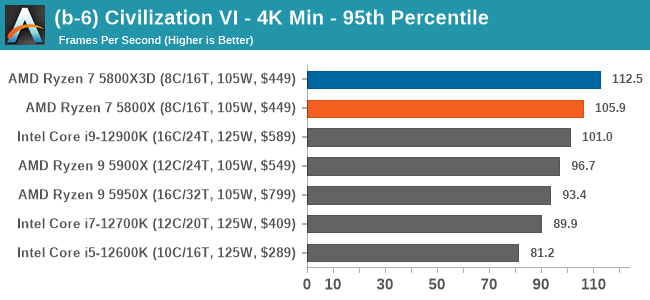
Final Fantasy 14
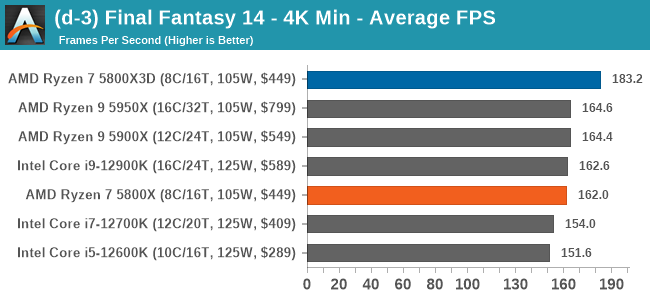
Final Fantasy 15
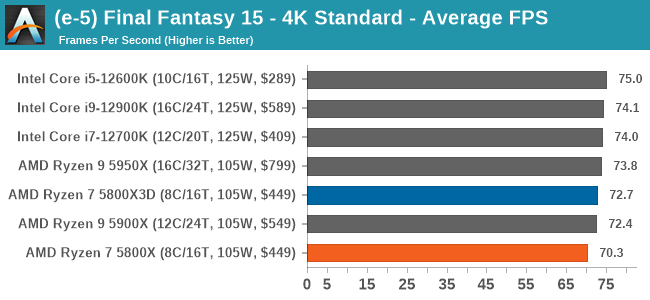

World of Tanks
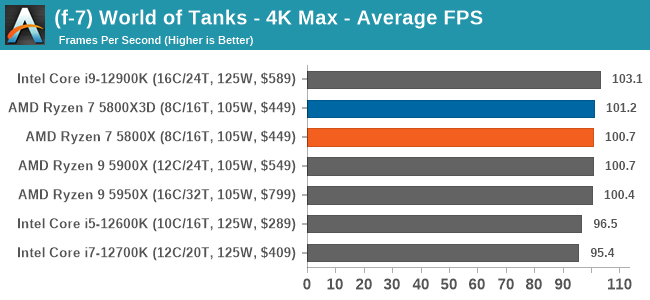
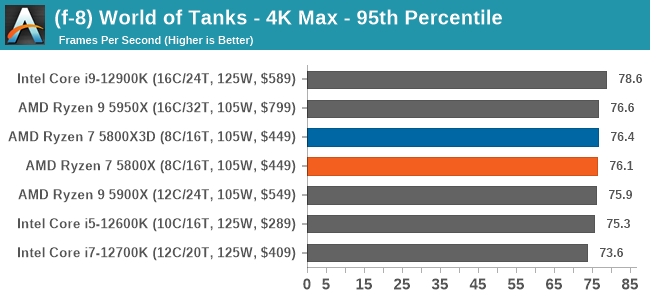
Borderlands 3
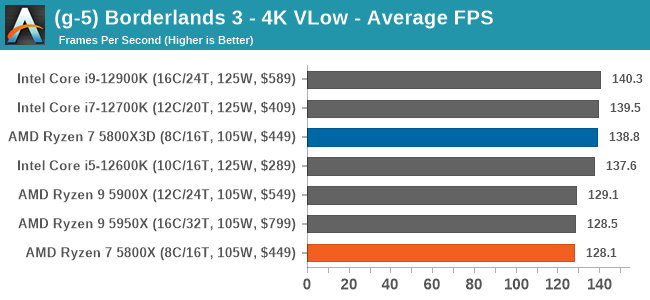
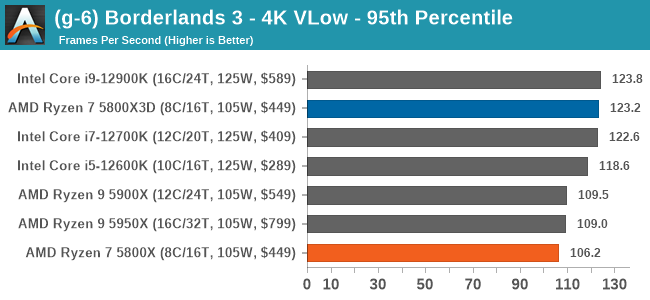
Far Cry 5
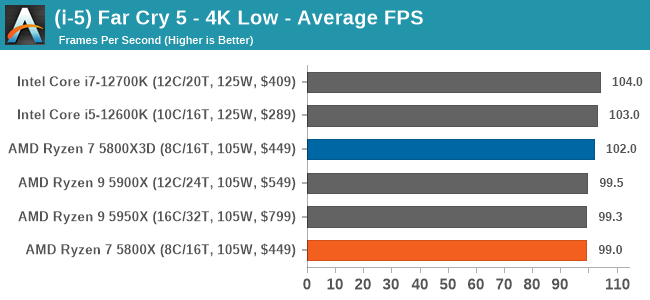
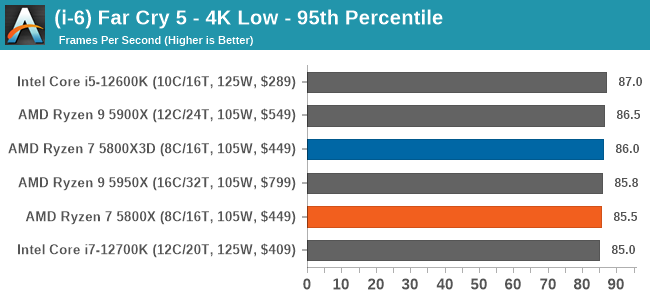
Gears Tactics
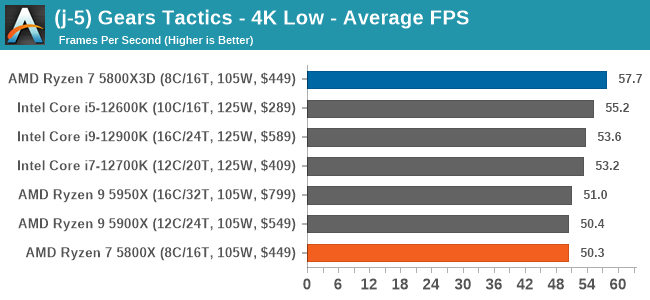
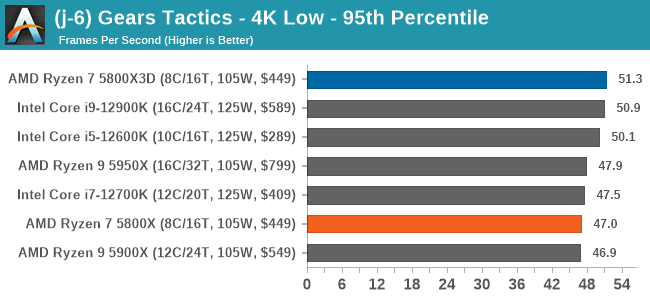
Grand Theft Auto V
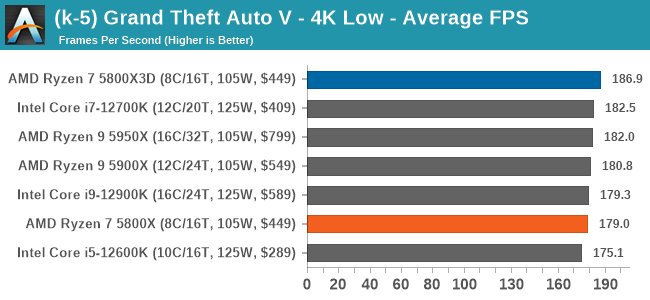
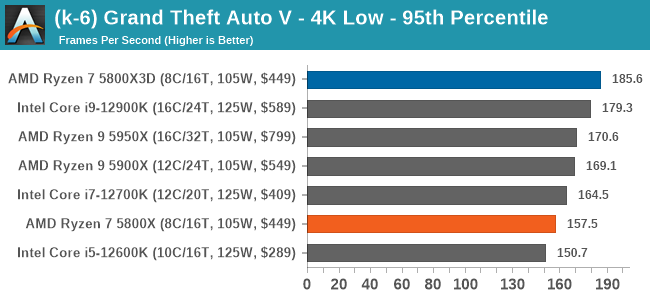
Strange Brigade (DirectX 12)
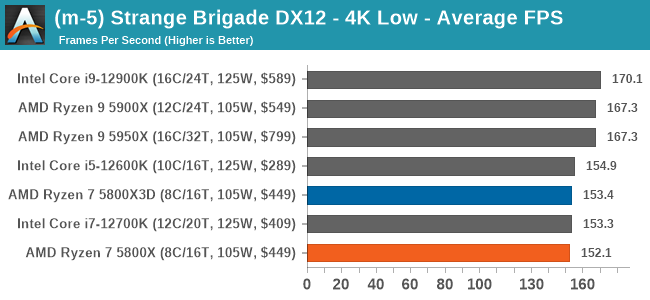
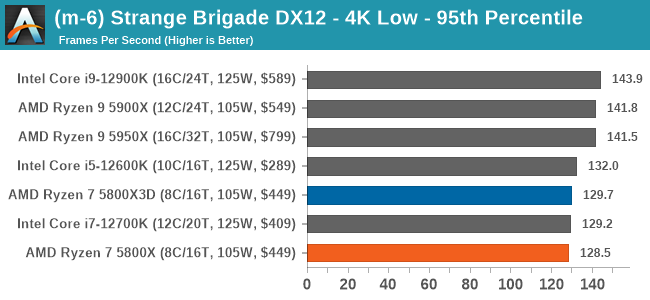
Strange Brigade (Vulkan)
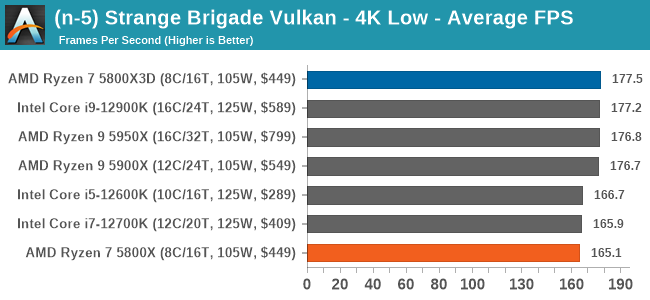
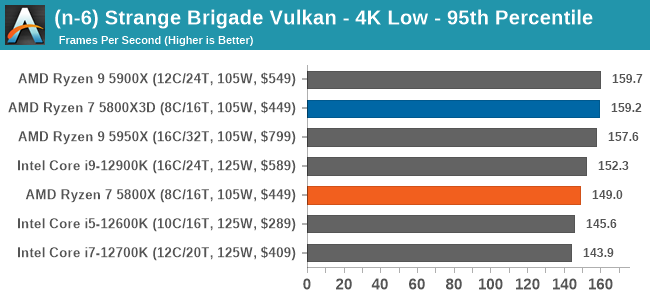
Typically when gaming at 4K resolutions, most games at these settings are GPU dependent with the CPU not usually having as much influence as a graphics card. In some of the games such as Final Fantasy 14, Grand Theft Auto V, and Strange Brigade, the additional L3 cache on the Ryzen 7 5800X3D did make a noticeable difference to performance.
In Strange Brigade, the Ryzen 7 5800X3D was top when testing with the Vulkan API, but in Direct X 12, the results were reversed, with the V-Cache making no difference in this scenario. Even in Far Cry 5 at 4K resolutions, the Intel 12th Gen Core did markedly better, which wasn't the case in our 720p and 1080p testing.
CPU Benchmark Performance: Power, Office, and Science
Our previous set of ‘office’ benchmarks has often been a mix of science and synthetics, so this time we wanted to keep our office section purely on real-world performance.
For the remainder of the testing in this review of the Ryzen 7 5800X3D, we are using DDR4 memory at the following settings:
- DDR4-3200
Power
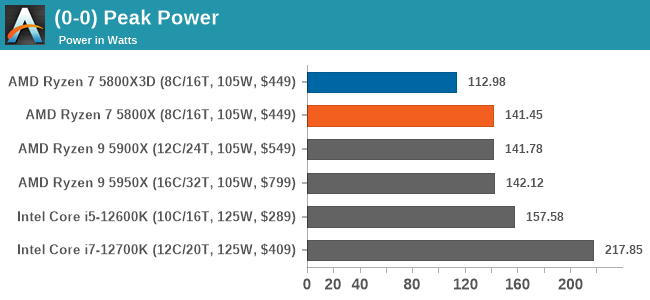
Looking at the power draw between the Ryzen 7 5800X3D and the other chips tested, it is more power-efficient than the original Ryzen 7 5800X. This could be down to a load VID core voltage as the 5800X3D is actually clocked lower by 100 MHz at turbo clock speeds.
Office

In our office benchmark, the newer Ryzen 7 5800X3D performs similarly to the previous Ryzen 7 5800X processor.
Science
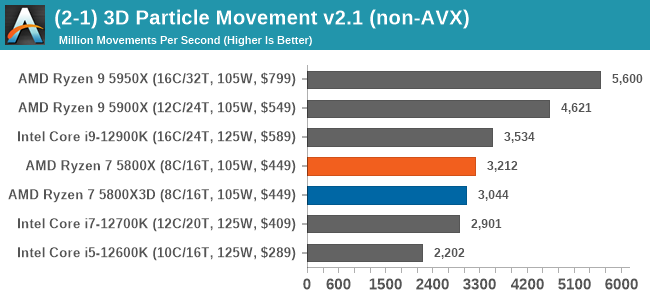
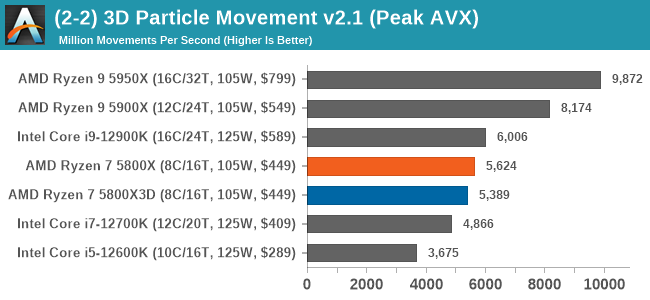
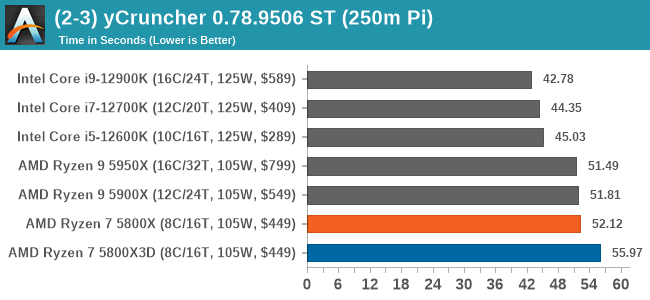

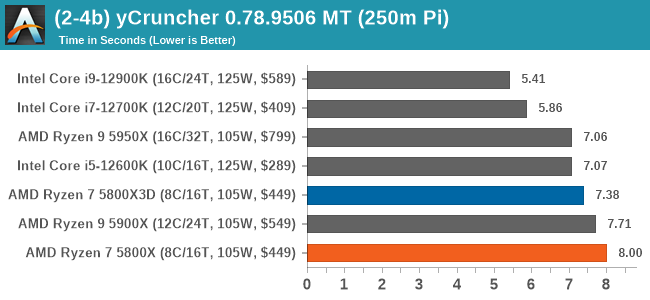
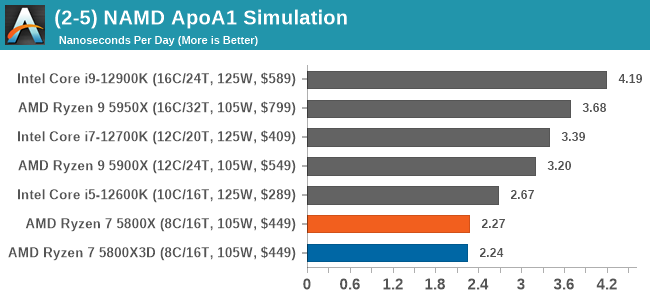
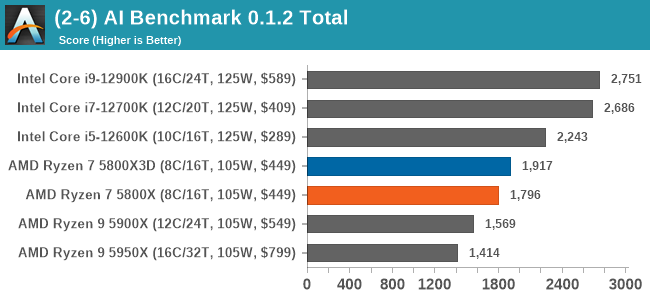
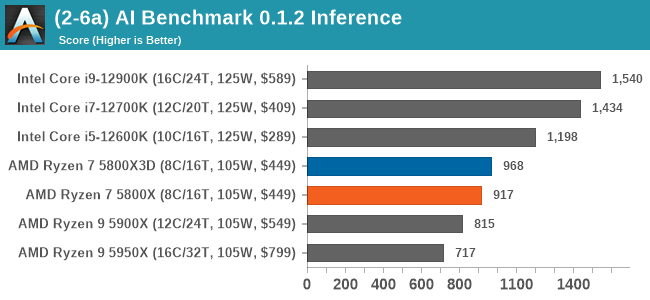
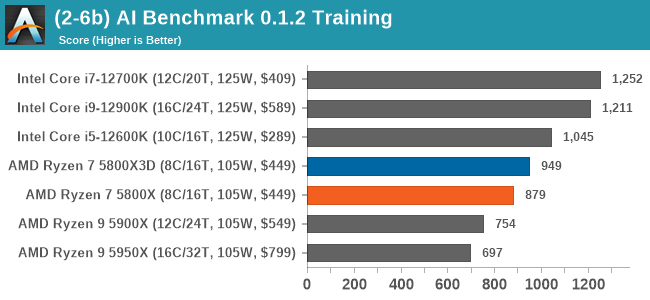
Our science-based benchmarks, for the most part, show that the Ryzen 7 5800X is slightly better computational-wise than the Ryzen 7 5800X3D. This is primarily due to the 5800X being clocked 100 MHz higher than the newer 5800X3D.
Where the extra L3 cache can benefit performance, it does, including in AI Benchmark, but overall the performance is very similar between both chips.
CPU Benchmark Performance: Simulation And Rendering
Simulation and Science have a lot of overlap in the benchmarking world, however for this distinction we’re separating into two segments mostly based on the utility of the resulting data. The benchmarks that fall under Science have a distinct use for the data they output – in our Simulation section, these act more like synthetics but at some level are still trying to simulate a given environment.
We are using DDR4 memory at the following settings:
- DDR4-3200
Simulation
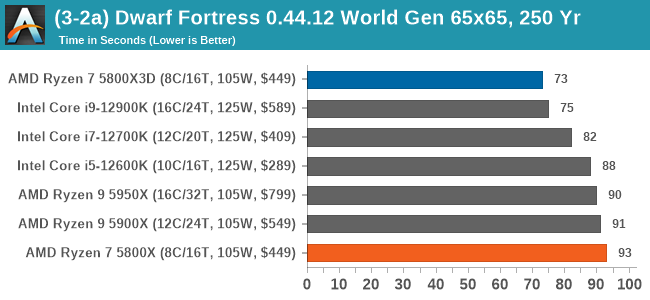
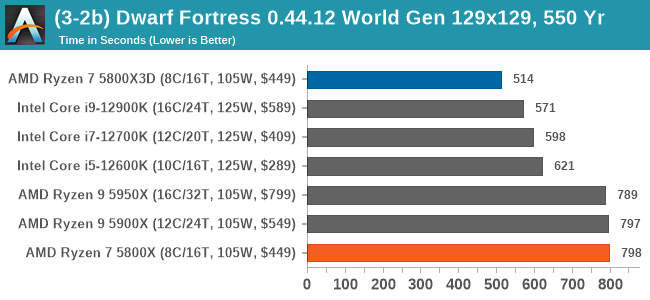

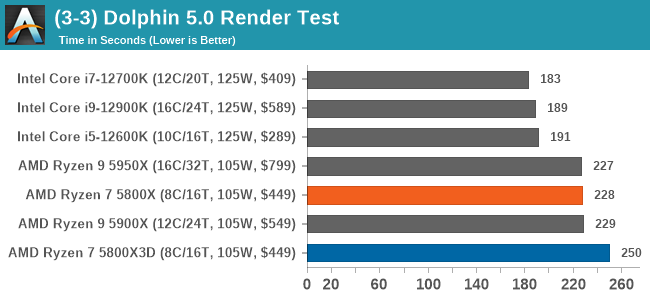
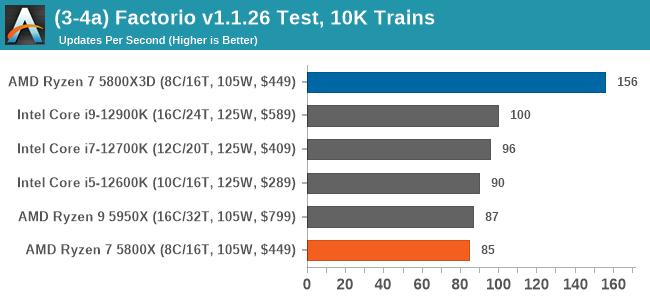
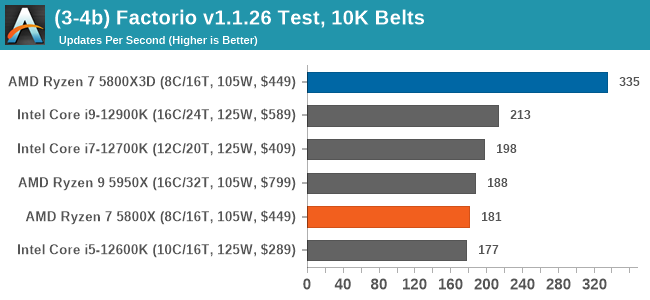
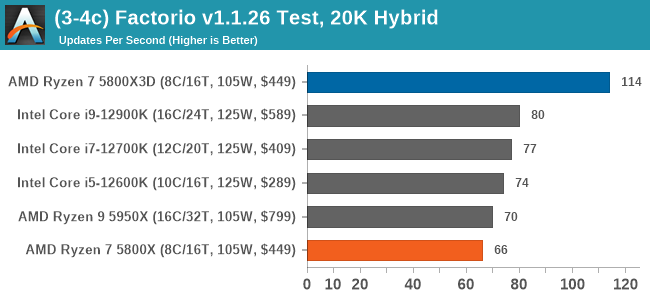
Rendering

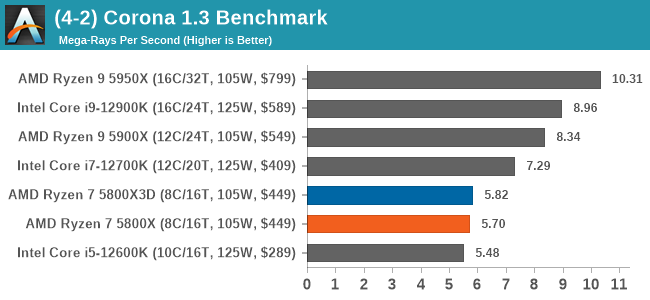
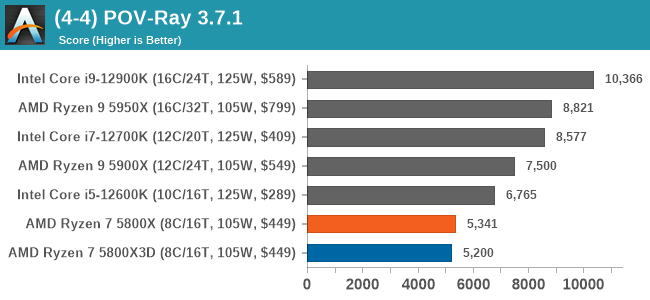
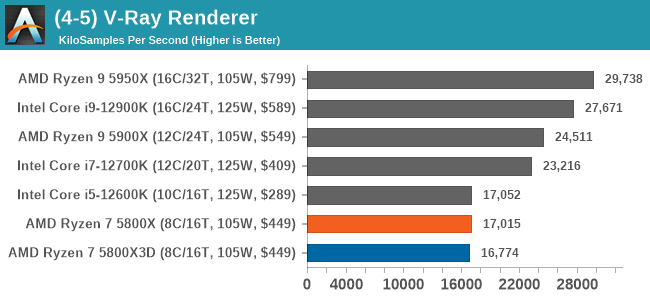
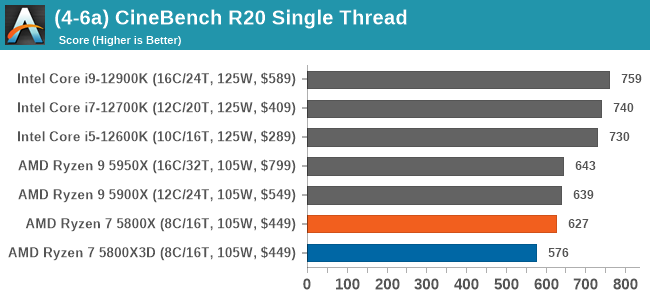
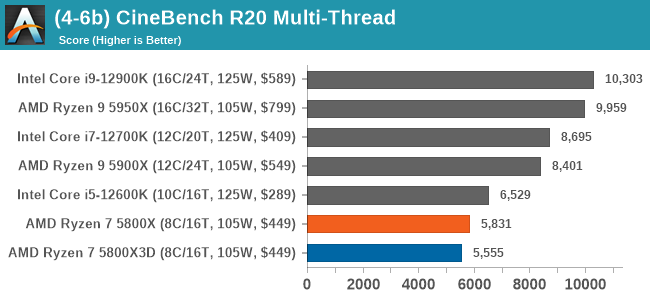
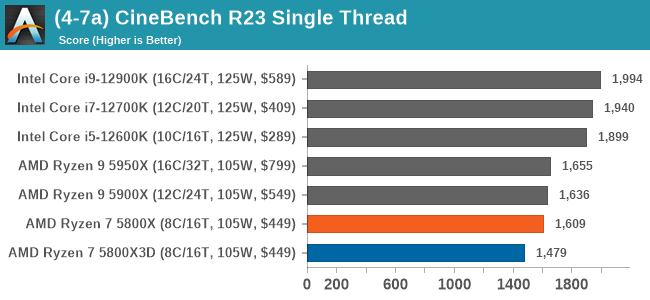
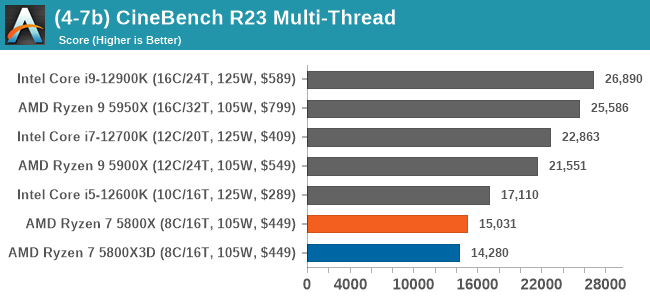
As we mentioned on the last page, where the Ryzen 7 5800X3D can use its 96 MB of L3 V-Cache to improve performance, it does, such as in our Factorio test. For the most part, it doesn't do enough in most situations to improve performance when compared to the Ryzen 7 5800X.
CPU Benchmark Performance: Encoding and Compression
One of the interesting elements on modern processors is encoding performance. This covers two main areas: encryption/decryption for secure data transfer, and video transcoding from one video format to another.
In the encrypt/decrypt scenario, how data is transferred and by what mechanism is pertinent to on-the-fly encryption of sensitive data - a process by which more modern devices are leaning to for software security.
Video transcoding as a tool to adjust the quality, file size and resolution of a video file has boomed in recent years, such as providing the optimum video for devices before consumption, or for game streamers who are wanting to upload the output from their video camera in real-time. As we move into live 3D video, this task will only get more strenuous, and it turns out that the performance of certain algorithms is a function of the input/output of the content.
We are using DDR4 memory at the following settings:
- DDR4-3200
Encoding
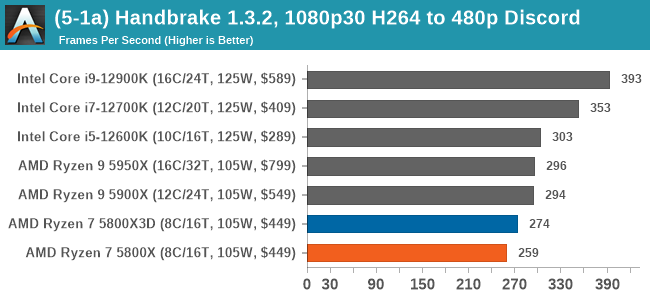
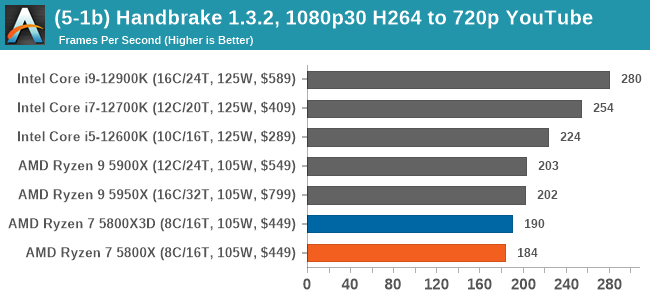
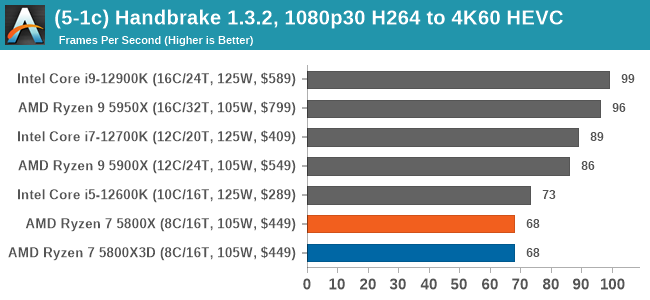
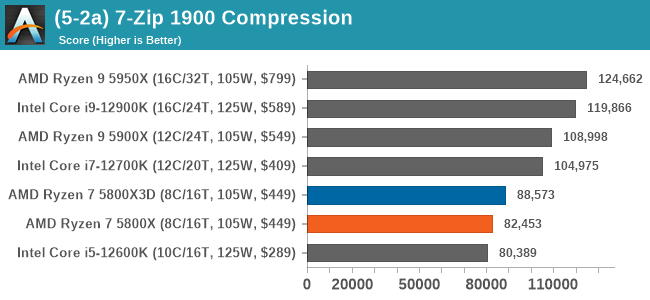
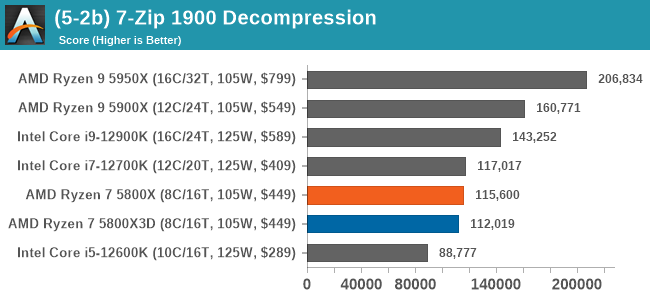
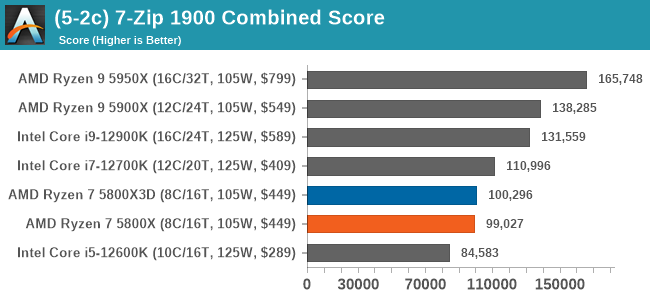
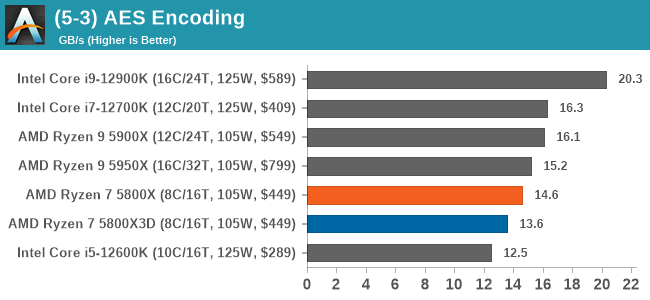
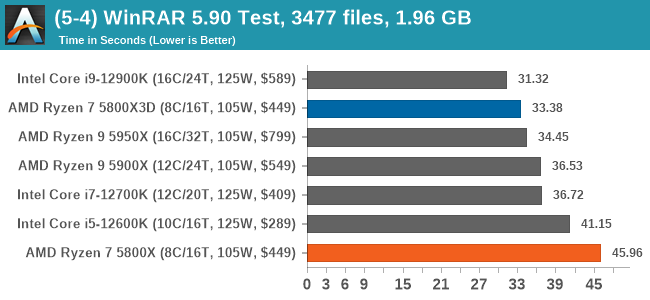
CPU Benchmark Performance: Legacy and Web
In order to gather data to compare with older benchmarks, we are still keeping a number of tests under our ‘legacy’ section. This includes all the former major versions of CineBench (R15, R11.5, R10) as well as x264 HD 3.0 and the first very naïve version of 3DPM v2.1. We won’t be transferring the data over from the old testing into Bench, otherwise, it would be populated with 200 CPUs with only one data point, so it will fill up as we test more CPUs like the others.
The other section here is our web tests.
We are using DDR4 memory at the following settings:
- DDR4-3200
Legacy
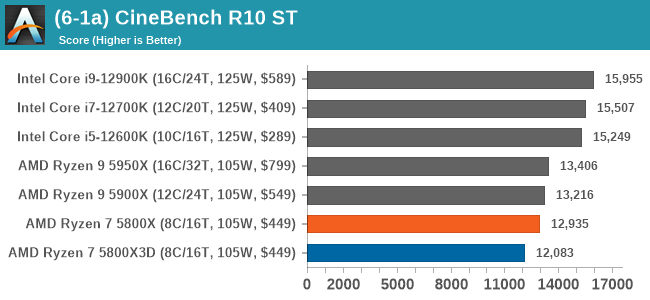
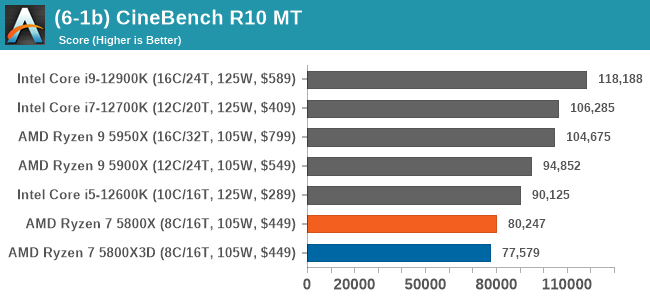
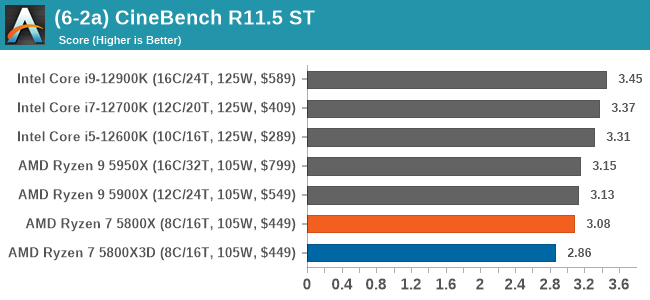
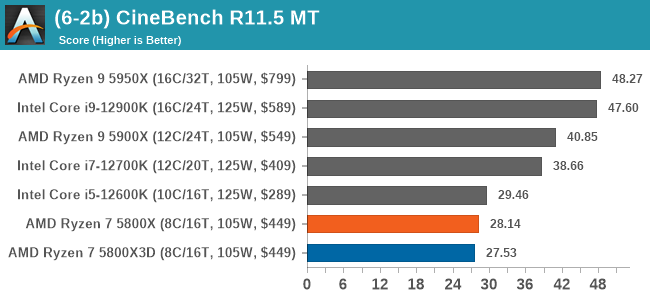
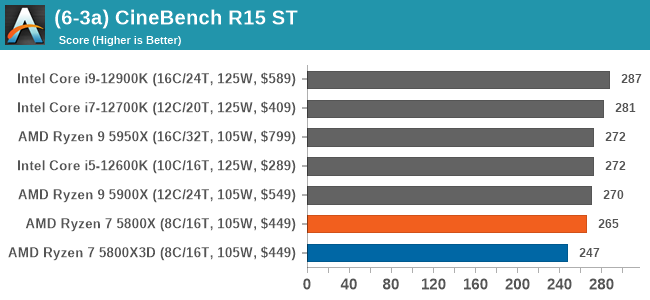
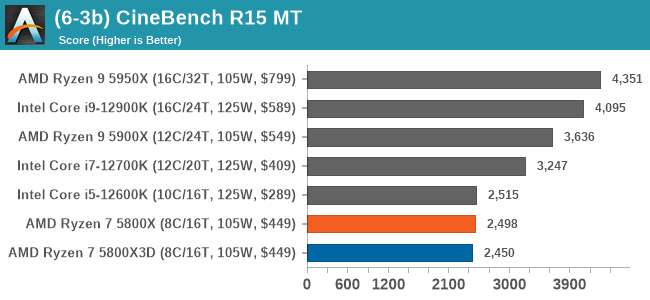
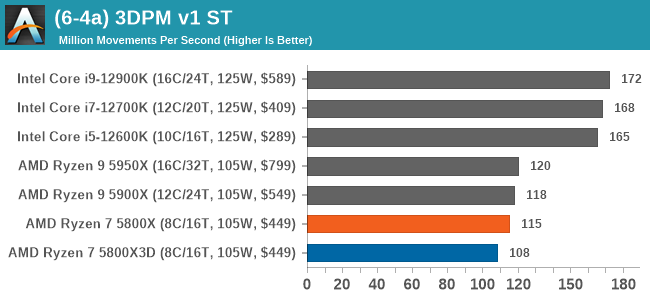
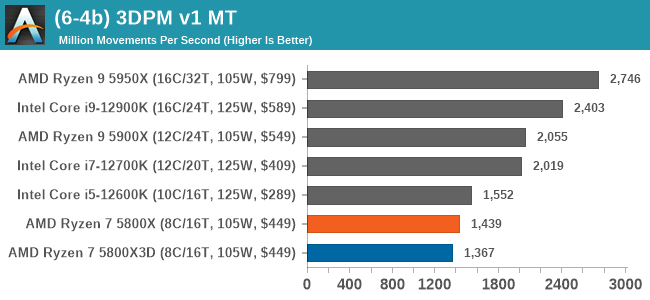
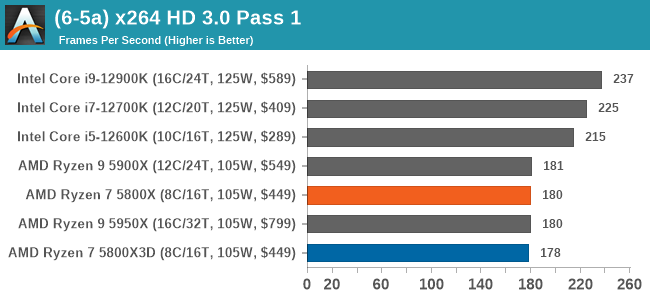
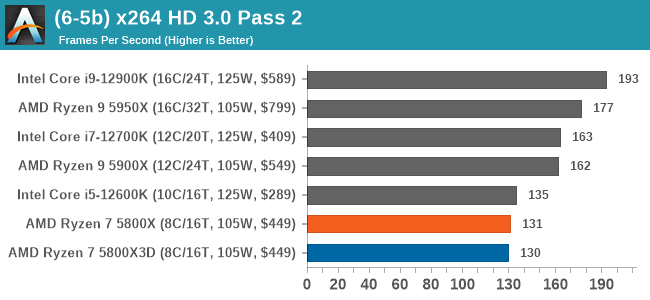
Looking at Ryzen 7 5800X3D's performance in our legacy section of our CPU test suite, it does seemingly lack behind the Intel 12th Gen Core series in terms of overall grunt. The most interesting element is that the discrepancy is clear to see between the clock speeds of the 5800X3D and the vanilla 5800X; the 5800X is slightly faster and is marginally better than the 5800X in compute-heavy tasks.
Web

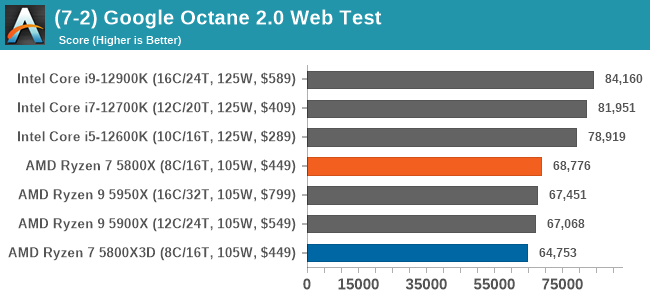
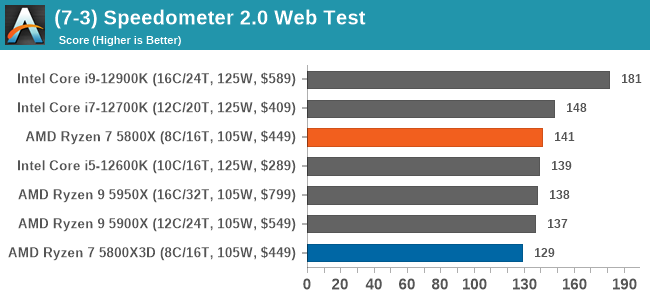
Even in our web-based tests, the regular Ryzen 7 5800X outperforms the 5800X3D with 3D V-Cache quite consistently. This shows that the additional L3 cache has no bearing on performance in this area.
Final Words
For users in the market for a new CPU designed to bolster frame rates in a gaming system, the AMD Ryzen 5800X3D is undoubtedly a powerful choice.
Even at $449, the Ryzen 7 5800X3D can perform as well, if not at times better than any chip from Intel's 12th Gen Core series of processors. The catch is that, as is often the case with new/unique technologies, the gains are uneven among games. This essentially means if the game doesn't benefit from the large 96 MB of 3D V-Cache onboard, it performs similar to the already existing Ryzen 7 5800X, which can be had for $350; $100 cheaper than the 5800X3D. In that respect, it would be helpful if AMD published a guide of games that they've found to materially benefit from the large L3 cache, just so gamers and users could decide whether the Ryzen 7 5800X3D is worth it.
The other angle is that, compared to the Intel ecosystem, the Intel Core i7-12700K for $380 represents a better buy in terms of all-around performance, where it has the advantage in most CPU compute workloads. So while the Ryzen 7 5800X3D has a niche it does quite well at, there's certainly an opportunity cost in getting this chip versus something that is a bit more rounded.
Let's dissect the performance across the different areas such as gaming and compute:
AMD Ryzen 7 5800X3D Analysis: Biased Towards Gamers
Looking at our data across our CPU testing suites (compute and gaming), the AMD Ryzen 7 5800X3D is a mixed bag. The Ryzen 7 5800X3D has an MSRP of $449 and represents a $100 hike over what the original Ryzen 7 5800X ($350) is currently selling for. Now let's dissect our analysis into two sections, gaming and compute, and piece it together.
AMD Ryzen 7 5800X3D Gaming Analysis: 3D V-Cache is Fantastic For Some Games (But Not All)
When AMD initially announced its Ryzen 7 5800X3D processor with its latest technological advancement in 3D V-Cache stacking, AMD made it clear that this processor was explicitly designed for gamers. The idea was that the additional levels of L3 Cache would play more to gamer's strengths with a larger buffer for more frequently used data instead of directly accessing it from system memory (DRAM). In gaming, a larger pool of L3 cache can indeed benefit and improve frametimes, as this data is closer to the CPU cores and is more quickly accessed by the individual cores from the processor as it would when accessing it from DRAM.
Now it's worth mentioning that in our testing, AMD's V-Cache-equipped chip didn't annihilate the competition in all of the games in our suite. Still, it certainly significantly impacted AMD-favored titles in its arsenal.

Looking at performance in Far Cry 5 at 1080p Ultra, which is notably an AMD partnered title, the AMD Ryzen 7 5800X3D with 96 MB of 3D stacked L3 Cache performed just under 27% faster than the previous AMD Ryzen 7 5800X processor. It was also around 9% better than the similarly priced Intel Core i7-12700K, which benefits from four more cores, higher IPC performance, and faster cores than the 5800X3D.

In Borderlands 3 at 1080p with maximum settings, the AMD Ryzen 7 5800X3D also topped our tables, even beating out the more expensive and premium Intel Core i9-12900K by over 1%, and beats all of the other Ryzen 5000 processors tested. This does give AMD some affirmation that its 3D V-Cache can push its technology as a win for gamers. Still, unfortunately, not every game title will benefit from massive levels of L3 Cache.

As for 4K gaming, there's not a lot to say here. This is almost always the realm of GPU-limited games, which limits the benefits a faster CPU can bring. Focusing on Final Fantasy 15 at 4K resolutions and using the standard preset, the 96 MB of L3 didn't have the desired effect on performance. The Ryzen 7 5700X3D does pull ahead, beating the previous Ryzen 7 5800X by around 3.4%, but it's small potatoes at this point.
AMD Ryzen 7 5800X3D Compute Analysis: Extra L3 Does Little For Compute Performance
While AMD pitched the Ryzen 7 5800X3D and its 96 MB of L3 cache as being beneficial in gaming, they didn't make the same kind of claims when it comes to applications and general compute performance. Because the benefits of a larger L3 cache are even more sporadic in these cases, AMD has wisely opted not to promote the part based on general compute performance here. Which is not to say that it's bad news for AMD, but as our data confirms, the L3 cache generally doesn't have much of an impact here.
It's worth noting that due to the 3D V-Cache, which is essentially 32 MB + 64 MB stacked vertically on top of each other using AMD's new chiplet packaging technology, AMD has had to be more conservative with core frequency to be in line with its 105 W TDP power rating. In comparison to the Ryzen 7 5800X, which has a base frequency of 3.8 GHz and a turbo core clock speed of 4.7 GHz, the Ryzen 7 5800X3D has a 400 MHz lower base frequency of 3.4 GHz, which its turbo core frequency is 200 MHz lower by comparison with a maximum core frequency of 4.5 GHz. This reduction in core frequency plays a key role in compute performance when directly comparing the 5800X3D and 5800X.

Looking at multi-threaded performance in Cinebench R23, the Ryzen 7 5800X3D performs 5.2% worse off than the existing Ryzen 7 5800X. This can be directly attributed to the differences in core frequency.

In our Blender 2.83 benchmark, the additional 64 MB of L3 cache on the Ryzen 7 5800X3D over the Ryzen 7 5800X made no difference in performance. Once again, the extra 3D stacked L3 V-Cache made no real impression on compute performance. With the critical sections of many non-gaming workloads either fitting within the confines of current L3 caches – or not fitting at all – there's no making up for more cores and higher clockspeeds most of the time.
AMD Ryzen 7 5800X3D is For Gaming, But Compute Performance is Average
Touted as the 'World's Fastest PC Gaming Processor' by AMD, this claim rings true in some aspects but not so much in others. The keyword in this claim is gaming, and it's true that the additional 64 MB of L3 cache does bring many benefits to the gaming market, albeit benefiting some games more than others.
The general outcome of our analysis is straightforward. If a specific title can benefit from a larger L3 cache, then the Ryzen 7 5800X3D and its 3D stacked V-Cache will prove very potent and fruitful to gamers looking to maximize frame rates. In situations where the game cannot benefit from the extra L3 cache, then the Intel 12th Gen Core series chips prove better with higher core clock speeds and higher IPC leading to higher overall performance.
The biggest benefits to gaming performance came in 720p and lower resolutions – which is to be expected since the CPU-limited scenario is something of a best case here – but the Ryzen 7 5800X3D at 1080p and 4K proved fruitful in selected titles. So even in workloads where the CPU isn't entirely free to run ahead of the GPU, it's clear that there's still some benefit to AMD's latest chip.
Otherwise, when it comes to raw compute performance, the Ryzen 7 5800X3D isn't as potent as Intel's 12th Gen Core processors – and in most of our computational-related tests, it also fell behind the vanilla Ryzen 7 5800X processor. This is because the L3 cache doesn't have as much of an influence on general purpose compute performance, and the Ryzen 7 5800X3D is clocked slightly lower due to voltage restraints (1.35 V) on the VCore.
Ultimately, It's pretty easy to make a case for the Ryzen 7 5800X3D as a solid gaming chip, especially as it decimates the competition in some titles. Just so long as potential buyers understand that the Ryzen 7 5800X3D is going to excel in gaming more than it excels in Excel. Otherwise, for users looking for a solid all-rounder capable of reasonable frame rates in gaming and reliable application and productivity performance, the Intel Core 12th Gen series has a little more oomph under the hood, albeit with a much higher power draw.
Performance matters aside, the Ryzen 7 5800X3D and its other V-cache ilk represent a massive step forward for AMD's engineering team. Stacking additional L3 cache is a novel way to expand the size of the L3 pool without significantly blowing up die sizes or resort to high-latency off-die caches, which gives AMD some important flexibility here to make such a part viable.
And clearly, AMD is happy with what they've accomplished as well. Along with the Ryzen chip, AMD has rolled out V-cache chips for enterprise and server products, where it is already playing a critical factor in performance. As a result, it comes as no surprise that AMD has confirmed that there will be 3D V-Cache products on its impending Zen 4 core (due fall 2022), and with Zen 5 which is expected sometime in 2024, with both consumer (Ryzen) and server (EPYC) products planned. So while all signs point to V-cache remaining a premium solution, it also means that we're far from done seeing what AMD can do for PC performance with larger L3 caches.

